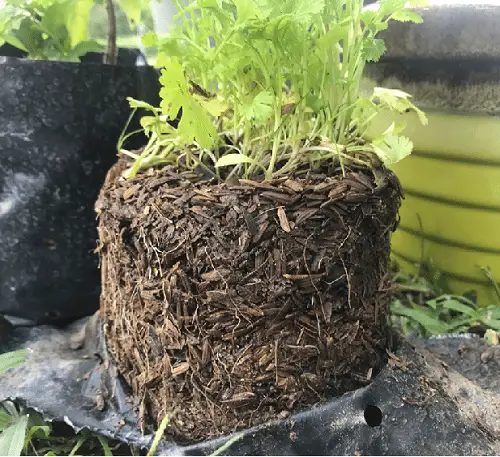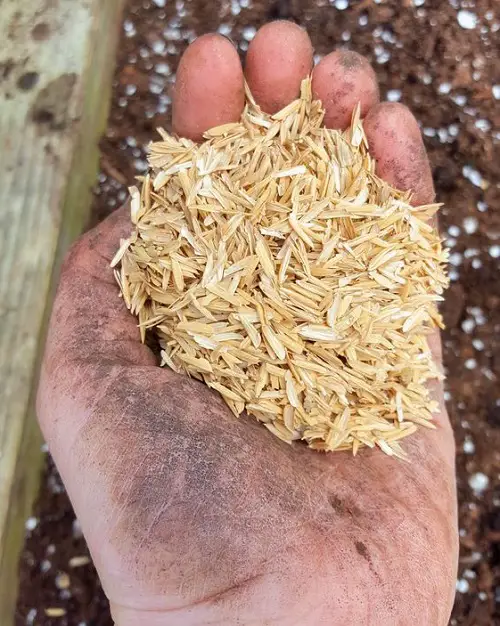Often discarded by people as waste, rice hulls hold surprising potential. Here are the 11 best Rice Hull Uses in Garden!

These brownish-yellow protective layers of rice grains are a natural, toxin-free help in your garden. Our guide will help you uncover their uses and make the most of them.
Note: You can get rice hulls even for free from local rice mills, farmers, and processing plants.
Rice Hull Uses In Garden
1. Regulates Temperature
We love plants basking in the sun, but if they get that a little too much, the soil can get scorching hot, and it’ll take a toll on their delicate roots. But here’s where rice hulls come in.
Rice hulls act as an insulating layer and help regulate soil temperature by keeping the soil cooler in hot weather. They’re light-colored and air-filled. Hence, they act like a reflective layer on top of the soil, bouncing a good chunk of sunlight away.
You can use them for your temperature-sensitive plants. Just apply a 1-2 inch thick layer of rice hulls over the soil surface around your plants as mulch.
2. Organic Matter For Your Soil
Rice hulls aren’t super rich, but they aren’t barren, either. They contain nitrogen (1.90%), phosphorus (0.48%), and potassium (0.81%), all of which are beneficial for your plants.
Rice hulls break down slowly over time and release small amounts of these nutrients and organic matter that feed the beneficial microbes in the soil. These microbes then churn out nutrients your plants can readily absorb.
Mix rice hulls directly into the potting mix for container plants or spread them as mulch around the base of your outdoor ones. Rice hulls only last a season, so make sure you repeat the process the next year.
3. Improves Soil Structure
The soil you choose can make or break a plant. Rice hulls are hollow and lightweight, which helps them break up compacted soil by creating air pockets, which improves the texture of any kind of growing medium. Mix one part husk with two parts soil, as this ratio creates a breathable medium for plants.
If you’re using them directly in the garden, incorporate them into the top 6-8 inches of your ground soil.
4. Good For Drainage
The air pockets that rice hulls create are also great for drainage. This improved aeration lets the water drain more effectively, so your soil won’t remain soggy, just moist. The soil will keep what it needs, and the excess will drain out.
If you’re starting with a new pot or plant, mix them in the soil in a ratio of 1:2.
5. Rice Hulls for Moisture Retention
Rice hulls can also keep your plants hydrated! The same air pockets that help with drainage also act as little water storage units. Add a 2-3 inch layer of rice hull mulch around the base of your plants; it will help prevent rot.
When you water, it will reach the empty pockets and get trapped here, creating a water reservoir for dry spells.
6. Get Neutral Soil with Rice Hulls
While soil amendments like peat moss are acidic, rice hulls have a naturally neutral pH of around 6-7. They can balance out the pH levels, maintaining a more balanced environment for your plants to thrive in.
7. Soil Erosion Control
Soil erosion due to heavy rains on a downward slope is painful! Mulch the topsoil with rice hulls, and when it rains, the husks will absorb the impact first.
8. Using Rice Hulls to Suppress Weeds
Let’s add another benefit of rice hulls in the garden! Use them to deter pesky weeds. Rice hulls act as a natural weed suppressant, not a weed killer. So a 1-2 inch layer of these on the topsoil can work like a shield, keeping weed seeds from germinating. If you have an invasive weed problem, try these homemade weed killers instead!
9. Overwintering Plants
Rice hulls can also help you overwinter your plants as they excel at creating a light and airy insulating layer that acts as a buffer against sudden temperature drops.
However, don’t use them if it’s cold and wet where you are. Wait until your plants have gone dormant for the winter, and then mound a 2-3 inch layer of rice hulls around their base, focusing on the root zone.
10. Useful In Vermicomposting
If you use worms for composting, consider adding rice hulls. Mix the husks into your worm bin with other compost materials, such as worm food scraps. Keep the ratio of rice hulls to food scraps around 30:70. This will create an ideal environment for the worms to thrive and produce high-quality vermicompost.
Pre-compost the rice hulls a bit by letting them sit in a pile with some water for 2-3 weeks to soften them up and make them more appetizing for worms.
11. Pest and Disease Resistance
Rice hulls are not guaranteed to protect against pests because they aren’t pesticides, but they do keep pests at bay. Their sharp, jagged edges make it harder for pests like worms and slugs to crawl across the plant. Rice hulls also contain silicon, which enables cell walls to become thicker and more resistant to fungal diseases.
Mixing rice hulls with diatomaceous earth can help deter pests like slugs, snails, and other ground-dwelling insects.


